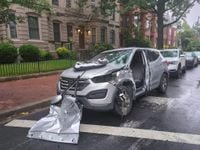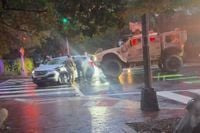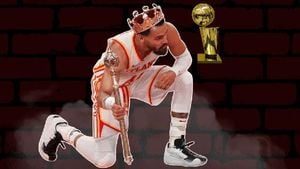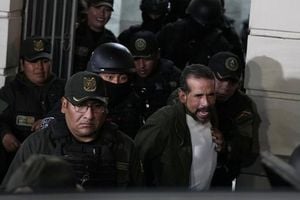On the morning of August 20, 2025, a routine commute in Washington, D.C.'s Capitol Hill neighborhood was shattered by the screech of metal and the unmistakable presence of military might. Just after 6 a.m., a Mine-Resistant Ambush Protected All-Terrain Vehicle (MATV)—a behemoth weighing nearly 14 tons and designed for war zones—collided with a civilian SUV at the intersection of 8th Street SE and North Carolina Avenue SE, about a mile from the U.S. Capitol. The crash, captured in videos and photos rapidly circulating on social media, left the civilian driver trapped and the city abuzz with questions about the growing military presence on its streets.
Emergency services responded within minutes. According to D.C. Fire and Emergency Medical Services spokesperson Vito Maggiolo, "We extricated the driver of the civilian vehicle…and that driver was transported to a local hospital with minor injuries." The driver, conscious and breathing, was rescued using the jaws of life—a detail confirmed by multiple witnesses and bystanders who shared footage online. The crushed side of the silver SUV, dwarfed by the armored military vehicle, became a stark symbol of the collision between military hardware and civilian life.
The MATV was part of a five-vehicle National Guard convoy, accompanied by a Metropolitan Police Department cruiser. The convoy had been deployed only hours earlier as part of President Donald Trump’s D.C. Safe and Beautiful Task Force initiative—a sweeping effort to crack down on crime in the nation’s capital. The deployment, which brought nearly 2,000 National Guard troops into the city, included reinforcements from six Republican-led states: Louisiana, Mississippi, Tennessee, Ohio, South Carolina, and West Virginia. These states alone contributed over 1,200 soldiers, swelling the ranks of uniformed personnel patrolling D.C. neighborhoods.
The timing of the crash could hardly have been more sensitive. President Trump’s declaration of a “crime emergency” earlier in August had already sparked heated debate and legal wrangling. Attorney General Pam Bondi, a key architect of the federal anti-crime initiative, announced on the same day as the crash that over 550 people had been arrested since August 7, including three known gang members, and that authorities had confiscated 76 illegal firearms from city streets. "Together, we will make DC safe again!" Bondi wrote on social media, underscoring the administration’s tough-on-crime stance.
Yet the sight of armored vehicles rolling down residential streets has left many residents and local leaders uneasy. Samuel Pastore, a neighborhood commissioner, voiced the concerns of many when he said, "The presence of oversized militarized ‘police’ forces is alarming, especially as children are preparing to return to school. These military vehicles don’t belong on our residential streets." The visual of a warzone-ready MATV towering over a crushed family SUV only heightened these anxieties.
D.C. Mayor Muriel Bowser, pressed for comment at a press conference later that day, acknowledged the incident but admitted her knowledge was limited. "I actually haven’t gotten a readout on that collision yet, other than I know we had a person, I believe one person transported for medical attention. So I can’t really say more," she told reporters, according to NewsNation. Bowser, however, has previously questioned the broader implications of deploying combat-ready troops in an American city. "The real question is why the military is being deployed in an American city to police Americans," she remarked, reflecting a sentiment shared by many city officials and residents alike.
As the dust settled at the intersection of 8th and North Carolina, the question of accountability loomed. The National Guard quickly announced an investigation into the crash, emphasizing their commitment to public safety. "The D.C. National Guard and JTF-DC remains committed to the safety of our service members and the public," the Guard said in a statement reported by WUSA9. The Metropolitan Police Department, for its part, declined to release a crash report, noting that no criminal offense was involved. MPD spokesperson Michael Russo explained that the absence of criminal activity was the reason for withholding the report.
The incident has also reignited debate over the militarization of law enforcement and the federal government’s intervention in local affairs. In the weeks preceding the crash, joint federal-local patrols became a common sight, following President Trump’s controversial move to assume greater federal control over D.C.—a policy that included an attempt by Attorney General Bondi to take over the Metropolitan Police Department, provoking a lawsuit from the city. The deployment of National Guard troops—many of them unfamiliar with the city’s unique layout and dense residential neighborhoods—has raised concerns about both effectiveness and public safety.
For residents of Capitol Hill, the aftermath of the crash was more than just another traffic incident. The visual disparity between the 14-ton MATV and the battered SUV captured the imagination and anxiety of the community. "This could have been worse. It’s a miracle nobody died," a local resident told NBC Washington, declining to give her name. "These streets weren’t made for tanks." In a video posted online, a woman can be heard confronting uniformed troops at the crash site: "You come to our city and this is what you do? Seriously?"
While the civilian driver’s injuries were minor and there were no fatalities, the symbolic impact of the crash has been significant. The presence of military vehicles in civilian neighborhoods, especially as children prepare to return to school, has become a flashpoint in the broader debate over public safety and civil liberties. Critics argue that the show of force is disproportionate and risks undermining trust between residents and authorities. Supporters of the deployment, on the other hand, point to the recent surge in arrests and weapons seizures as evidence that the crackdown is producing results.
The cause of the crash remains under investigation, with the National Guard and local law enforcement working to determine exactly what happened in those early morning hours. In the meantime, the city is left to grapple with the realities of a federal intervention that has brought both a sense of security and a new set of risks to its streets. As the debate continues, one thing is clear: the collision at 8th and North Carolina has become a potent symbol of the tension between order and freedom in the nation’s capital.
For now, Washington, D.C. residents are left with the image of a crushed SUV and an armored vehicle looming over a quiet neighborhood—a reminder of how quickly the extraordinary can become the new normal.





